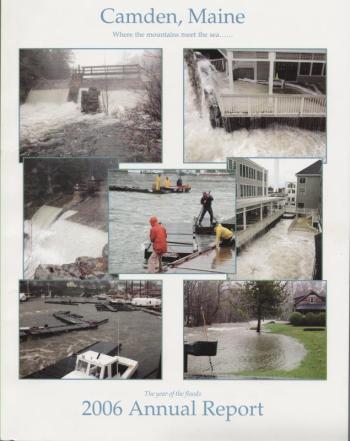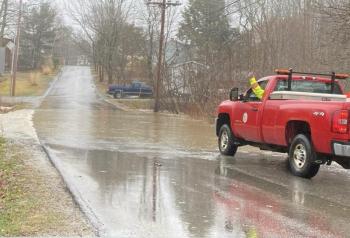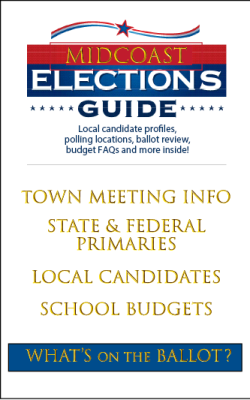letter to the editor
Camden’s watershed moment
Mon, 06/10/2024 - 7:30pm
Weighing in on local elections is no fun in a small town, and I can respect whatever decision is made by voters. I also understand that most people don’t have time to sort through everything and that they are overwhelmed by the amount on the ballot. It may be helpful to remember that everything on the ballot this year is on there because the people elected to the Select Board voted for it. At least a majority of us.
We listened and read and argued and edited and then invited multiple rounds of public comment through various boards and committees and the general public and then revised things again. The voters can choose to ratify or not but keep in mind that a lot has already gone into creating a compromise between a very diverse group of people. It’s a wonder we could agree on anything, but we did, and I believe everything on the town ballot deserves a yes vote. That’s how I will vote. Here’s a link to more detailed information
When it comes to the Select Board, I want to reiterate that I can work with anyone and I like and respect all of my current colleagues as well as the candidates.
For those interested, I am supporting Susan Dorr and Sophie Romana for multiple reasons, but one of those is time sensitive and important to many people concerned with keeping Camden’s expenses manageable. We have seen how expensive it gets when Camden tries to go it alone and ignore the environmental priorities and incentives that the rest of the nation is embracing, and we are at a crossroads.
The Select Board doesn’t have a lot of power in Camden because we are not a City Council. We essentially vote on what to give you all for consideration.
But there are two things that a majority of the Select Board can do or not do that you should be aware of when deciding who to vote for: They can decide what you get to vote on, how it’s worded, and, just as importantly, whether or not the town can accept and apply for grant funding.
Unfortunately, this election is turning into a referendum on river restoration and it may determine whether we receive future funding at all for coastal resilience planning and solutions to problems such as the Harbor Park sea wall.
There are two candidates who have made their positions clear. They don’t support any changes to the dam and will work to prevent further study or action in that direction. They also don’t support the town applying for grant funding from the National Coastal Resilience Fund and other similar opportunities. This could get very expensive very fast if we try and address all of these issues with no grant funding.
We have options that will be free to local taxpayers and options that are going to be very expensive, but doing nothing is not an option. So the fact that Camden has received national recognition is a really big deal. We live in a special place when it comes to natural resources and both the National Fish and Wildlife Foundation and NOAA recognize that. We also live in an area vulnerable to extreme rain and storm surge events that are increasingly.
As I read over candidates statements and listened to some of the forum responses, there is a lot I agreed with from everyone, but also some things that are flagrantly wrong and being repeated recklessly despite having been corrected in the past.
The 100-year flood events we had were not rain events. Camden hasn’t had a 100-year rain event in a very long time. We have frequent 50 year rain events that cause significant problems. Just look at the cover of the 2006 town annual report. Our most recent event was May 1 of 2023 where much of the watershed received around 5 inches, but Camden got less. I will write more on this another time, but the problems are significant and we are so often just one variable away from the type of catastrophic rain we’ve been seeing on the news.
Camden is eligible and well positioned for an incredible amount of assistance to address issues throughout the Megunticook Watershed and the public properties in the vicinity, especially Harbor Park, which is crumbling due to more intense storms, sea level rise and river flow.
All towns are having this issue, but Camden is eligible for much larger sources of funding for one major reason: Habitat restoration potential.
Coastal watersheds are vitally important for fish who move back and forth between fresh and salt water. This means that if we can incorporate nature like fish passage into the design for Harbor Park and the Montgomery Dam, it can be paid for through federal funding if voters approve of the plan that is being prepared for a November vote.
The Megunticook River Citizens Advisory Committee is reviewing designs and will ultimately make a recommendation to the Select Board. Read about what they’ve learned here. But if the people on the Select Board at the time are not in agreement, they can prevent the town from securing the funding and they can keep the plan from going to voters.
Closing the door on fish passage means that every single one of Camden’s dams will be ineligible for grant funding that can help with structural repairs that we’ll be on the hook for no matter what.
With no river restoration plan, all the sediment trapped behind the dam near the skate park will just continue to fill up and contribute to algae growth and oxygen depletion. When the Knowlton Street Dam finally succumbs to the elements, as it is close to doing, massive amounts of sediment could be transported to the harbor without planning (as has happened in the past).
With no solution for Montgomery Dam, the entire watershed and all of the connecting culverts and dams fall out of priority funding opportunities. These are problems that will cost millions of dollars to solve and by failing to deal with them now when we have the opportunity, we are just burdening our children with the problem later on.
Why is there so much funding available for ecological restoration projects? Aside from all the benefits of ecological restoration, there’s another simple answer. Democrats and Republicans can’t seem to agree on anything else.
When it comes to guns, abortion, health insurance or immigration, they’re not making any progress. But no one wants all the fish to die. They can agree that a lot of things in this country are falling apart and that building back in better harmony with nature is a good thing when possible.
They don’t necessarily agree on why the climate is changing, but they can agree that the National Flood Insurance Program is bankrupt and that we should be preparing for more water in faster bursts. So with all the worthy projects and causes out there, restoring a natural habitat that can be enjoyed by all is something that a wide range of people can agree is important.
It has been described as a once in a career opportunity given the amount of money made available through the bipartisan infrastructure act. But after 2026, the funding environment may change drastically.
This is just the latest round of inevitable transitions. Just like massive federal funding has been used for cleaning up industrial sites, building wastewater treatment plants and finding sanitary ways of dealing with trash, we are at another moment where we must plan for the next 100 years and clean up the mess from the previous 100.
The Clean Water Act came with a carrot and a stick, providing towns, cities, and private parties with an incentive to stop discharging untreated sewage directly into water bodies. Towns that built wastewater treatment plants before a certain date were rewarded with large federal grants to defray the cost. Those who didn’t, missed out on the incentives and still were forced to come up with solutions in the long run.
Camden and Rockport are the easiest examples of this. In the 1960s, most Camden residents started to see the writing on the wall. They either wanted our lakes, rivers and harbors cleaned up or they became convinced that eventually we wouldn’t have a choice. A little bit of both, maybe.
By a slim margin, voters approved borrowing for the project, and since we got it done before the 1970 deadline, roughly 85% was paid for with federal funds.
Another looming problem with a deadline was the dump problem and the need to cease the practice of open burning and tossing trash into a water-filled quarry. In this instance, we adopted a different approach with state and federal agencies. Delay, fight, deny, and then hire many experts to prove that our way of operating was fine.
As a result, while Rockland will have ¾ of the costs of landfill closure reimbursed by the state, Camden, Rockport, Hope, and Lincolnville will have to fund our closure alone.
Anyone can see that major changes are needed to the Montgomery Dam. Buildings on Main Street can’t even make repairs without draining the entire pool. If it’s going to be a pond, it should be treated like a pond. Sometimes we can’t even drain the pool because there’s too much water and sometimes it can’t stay full because there’s not enough, but it’s all very expensive to fix.
We have a choice: Take the proactive path of our wastewater treatment plant planning or the model of environmental defiance at the dump. Sophie Romana and Susan Dorr will help make sure that Camden voters get all the information and a chance to vote based on the facts. So many towns would love to be in our position.
Alison McKellar is on the Camden Select Board and lives in Camden


































